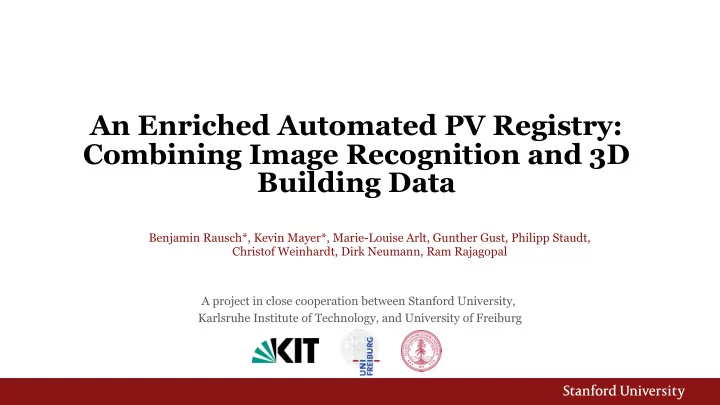

An Enriched Automated PV Registry: Combining Image Recognition and 3D Building Data Benjamin Rausch*, Kevin Mayer*, Marie-Louise Arlt, Gunther Gust, Philipp Staudt, Christof Weinhardt, Dirk Neumann, Ram Rajagopal A project in close cooperation between Stanford University, Karlsruhe Institute of Technology, and University of Freiburg
Motivation & Contributions • Accurate and up-to-date databases of decentralized generation units are indispensable for optimized systems operations • Previously, CNNs have been used to automatically classify solar panels from aerial imagery and to create databases on a country scale, e.g. DeepSolar by Yu et al., 2018 1 • Yet, previous studies do not account for the tilt and orientation angle of detected systems In this work, we: Ø Combine aerial imagery with 3D building data to enrich detected PV systems Ø Show that our approach enables improved PV generation capacity estimates Ø Compare our automated PV registry with Germany’s official registry 1 Yu, J. et al. (2018) ‘DeepSolar: A Machine Learning Framework to Efficiently Construct a Solar Deployment Database in the United States’, Joule. Elsevier Inc., 2(12), pp. 2605–2617. doi: 10.1016/j.joule.2018.11.021.
Data Sources Image Data 2 3D Building Data 2 PV registry 2,3 Provides a rooftop’s Provides info on PV GSD: 0.1 m/pixel systems > 30kW tilt and orientation Combine publicly available datasets to obtain new insights 2 Publicly available dataset 3 Abbreviated as MaStR henceforth
Methodology a. b. c. Notes: a. Only aerial images classified as depicting PV systems are propagated for segmentation b. PV systems depicted as real-world coordinate polygons are intersected with rooftop polygons c. Detected PV systems and their respective capacity estimates are aggregated per address Creating an enriched automated PV registry is a sequential process
Results: Classification and Segmentation Classification: Ø Precision: 87.3% Ø Recall: 87.5% Segmentation: Paper MAPE [%] mIoU [%] GSD [cm] Camilo et al. 4 - 60 30 DeepSolar 1 24.6 - 5 SolarNet 5 - 90.9 5 This work 18.5 74.1 10 Classification and segmentation on par with recent studies 4 J oseph Camilo, Rui Wang, Leslie M Collins, Kyle Bradbury, and Jordan M Malof. Application of a semantic segmentation convolutional neural network for accurate automatic detection and mapping of solar photovoltaic arrays in aerial imagery. arXiv preprint arXiv:1801.04018, 2018. 5 Xin Hou, Biao Wang, Wanqi Hu, Lei Yin, AnbuHuang, and HaishanWu. SolarNet: A Deep Learning Framework to Map Solar PowerPlantsIn China From Satellite Imagery. 2020. URL https://arxiv.org/pdf/1912.03685.pdf.
Results: PV Capacity Estimation with Tilt Angles Incorporate rooftop tilt to correct PV area estimated from a bird’s eye view MedAPE 6 [%] Approach This work (no tilt) 25.9 This work (including tilt) 16.1 Rooftop tilt significantly improves PV capacity estimates 6 Denotes the Median Absolute Percentage Error
Results: Comparison with MaStR 7 in Bottrop • Duplicated entries Ø Approx. 3.2% of MaStR’s entries are duplicates • Erroneous capacities Ø MaStR contains substantially inflated entries • Multiple entries per address in MaStR Ø Impractical for registry-based analyses • False addresses Ø MaStR lists 24 out of 160 entries with a false address • Missing entries Ø We identify 21 PV systems not listed in MaStR For Bottrop, MaStR lists 29,758 kWp, while our automated registry arrives at 32,286 kWp 7 Germany’s official PV system registry
Discussion and Outlook • State-of-the-art results in classification and segmentation Incorporating a rooftop’s tilt enables accurate PV capacity estimation • Approach to automatically construct, update, and enhance PV registries • • Future research: Ø Improve PV supply forecasting and nowcasting Ø Enhance integration of EV charging, PV systems, and grid reinforcement
Recommend
More recommend